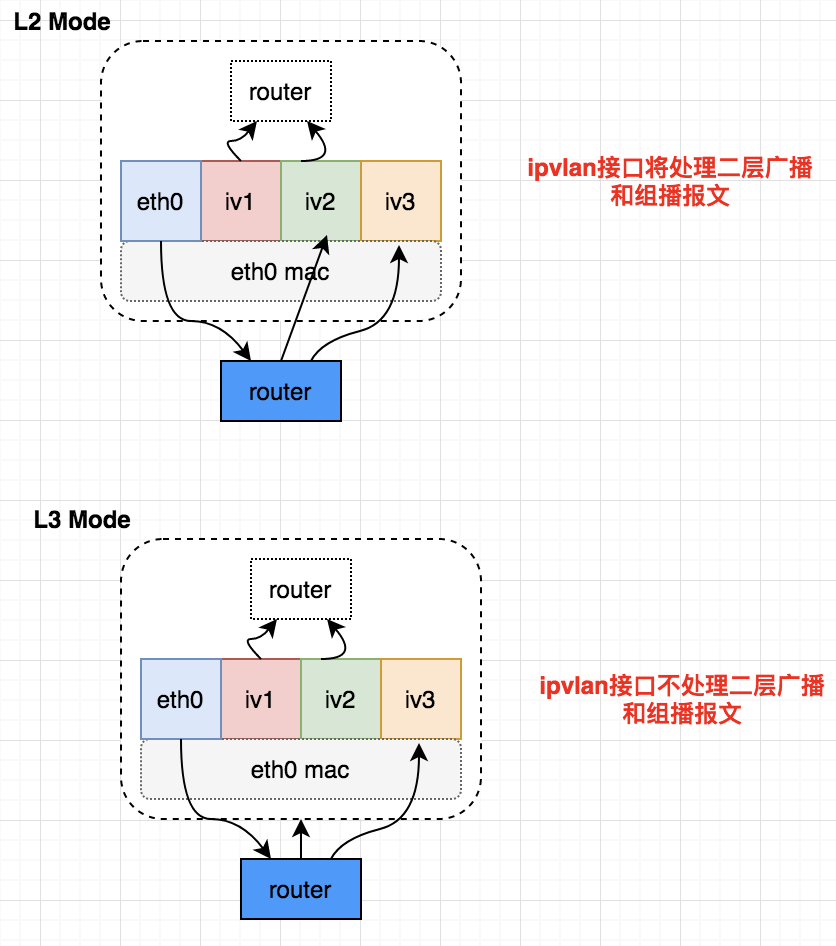IPVLANs are similar to MACVLANs in that they both virtualize multiple virtual network interfaces from a single host interface. An important difference is that all virtual interfaces have the same mac address and different ip addresses.
Because all virtual interfaces share a mac address, there are some things to keep in mind.
- The DHCP protocol generally uses the mac address as the machine identifier when assigning an ip. In this case, the client needs to configure a unique ClientID field when dynamically acquiring the ip, and the DHCP server should be properly configured to use this field as the machine identifier instead of using the mac address
Ipvlan is a relatively new feature of the linux kernel. The linux kernel started to support ipvlan in 3.19, but the recommended version is >=4.2 (because of a bug in docker support for previous versions), see the kernel directory for the code:
/drivers/net/ipvlan/.
Working mode
A simple way to create an ipvlan is
|
|
L2 mode
ipvlan L2 mode works very similar to macvlan bridge mode in that the parent interface acts as a switch to forward data from the child interfaces. Sub-interfaces of the same network can forward data through the parent interface, while if they want to send to other networks, the messages will be forwarded out through the parent interface’s route.
L3 mode
ipvlan functions a bit like a router, it does the job of routing and forwarding different network messages between each virtual network and the host network. As long as the parent interface is the same, virtual machines/containers can ping each other even if they are not on the same network, because ipvlan does the message forwarding in the middle.
Note that virtual interfaces in L3 mode do not receive multicast or broadcast messages (in this mode, all networks are sent to the parent interface, and all ARP processes or other multicast messages are done at the underlying parent interface). In addition, the external network is not aware of the ipvlan virtual network by default, and the ipvlan network cannot be accessed directly by the external router without configuring the corresponding routing rules on the external router.

Practice
Create IPVlan L3 mode
Note that the MAC addresses of ipvlan1 and ipvlan2 are the same as those of the ens224.
|
|
Create ns binding interface
Configure IP
Add Routing
ping test, 2 ns can ping through each other normally, can’t ping through the host IP
catch ARP messages, the results can not catch ARP in L3 mode, indicating that layer 2 broadcast and multicast are not handled, working in L3.(This is the difference with L2 mode)
|
|
Create L2 mode, the rest of the operation is the same as L3
The difference is that L2 can capture ARP messages in 2 ns
Summary
The external network in ipvlan L3 mode is not aware of the virtual network of ipvlan by default. If the corresponding routing rules are not configured on the external router, the network of ipvlan cannot be accessed directly by the outside.
CNI Configuration
The cni configuration format is
It is important to note that
- Under the ipvlan plugin, the container cannot communicate with the Host network
- The host interface (i.e. master interface) cannot be the master interface of both ipvlan and macvlan
Reference https://houmin.cc/posts/d8c1414f/